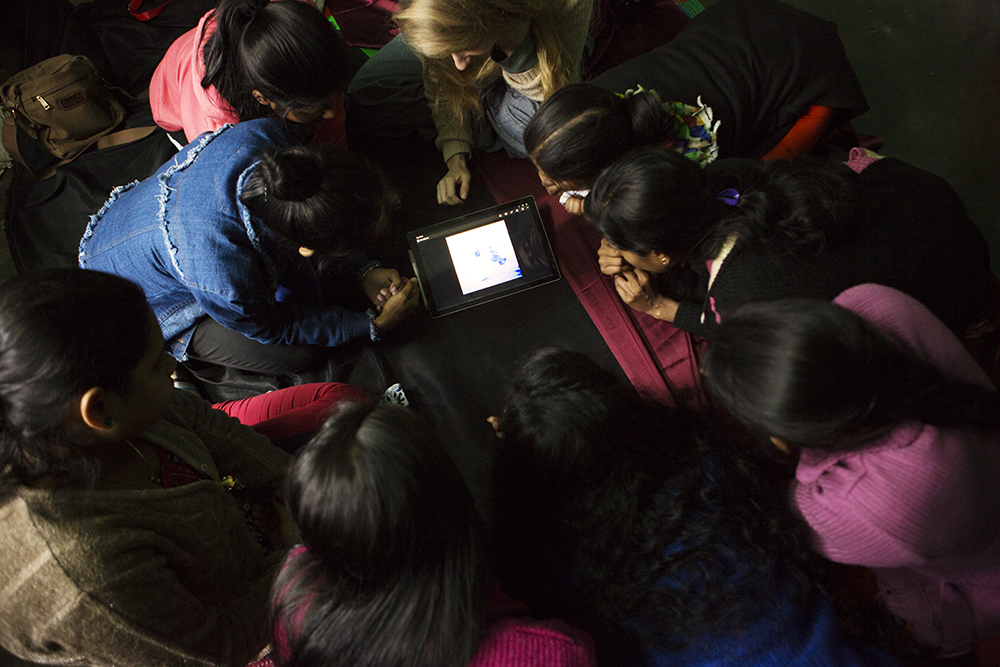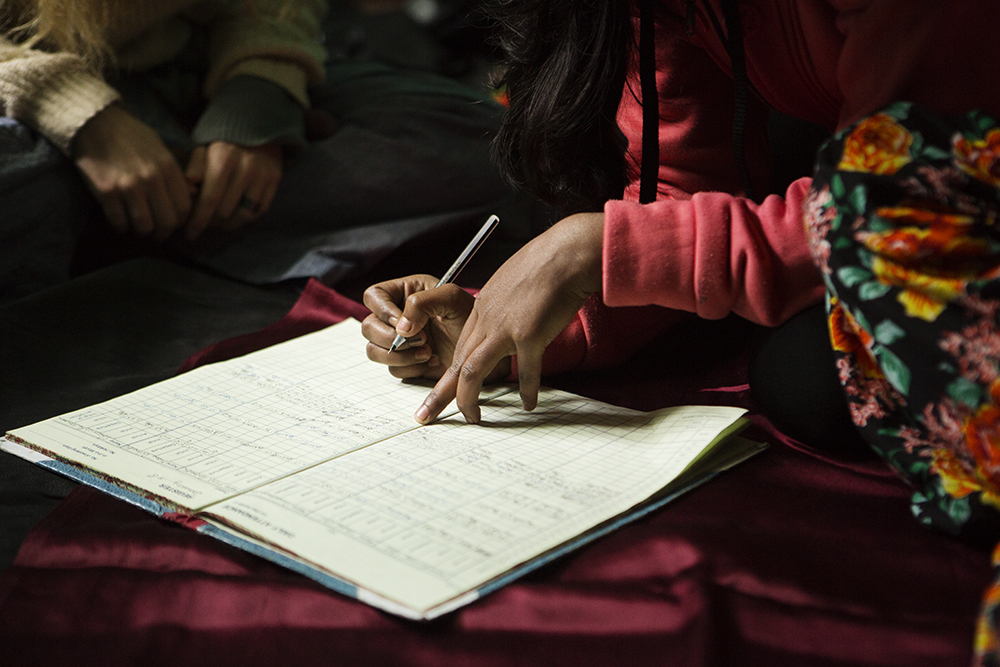The Culture of Light

I’m in a small room in India – West Bengal. Outside the horns are blowing like crows, attacking. People are yelling down the street, their voices drowning together, indecipherable. This is a place that envelopes me the moment I step foot outside the airport, but it challenges me, too. The sounds, the people, the food, the smells, the stories. The stories.
When I listen closely through the mountainous shouts I hear cross-sections of lives; one man tells another to be careful crossing the street, not through his words, but through his body language. A woman kisses her child while a hundred people push past her, tenderness going unnoticed.

In my workshop I’m teaching self-expression through photography and movement, aided by Kolkata Sanved. The young women that sit in the room with me have pasts that I cannot imagine. I try, but it feels wrong to imagine my life with the same difficulties; disrespectful, somehow. I am ill-equipped to feel what they feel, at least precisely. My life has been vastly different and that shows in every minutiae when I travel in India. In the ways that I get irritated by people bumping into me, when I feel exhausted by the crowds, and especially when I feel trapped by the buildings and pollution. That is life here, though, and I am unaccustomed, even after five years of coming.

Today in the workshop we are learning storytelling. I explain why this is important – because, after all, their story is theirs. It is for them to tell, not me. I never felt comfortable photographing people whose lives have been so uniquely different from mine, using my way of telling stories to tell theirs. This is for them to share. Instead, I teach storytelling. I teach how to use a camera. I teach self-portraiture. I teach them how to tell their own stories.
And so they do, effortlessly.
Because storytelling is the culture here. This is a place where stories pile on top of stories so that every object, every location, is imbued with the deepest stories.
Even more than stories, though, is the hope that permeates.


I’m in the Kolkata Sanved office and day one of my workshop is almost over. We are talking about our stories, but not in literal terms. I never, ever ask someone to share their past. Instead, we speak in symbols, in emotions. I ask them to bring me an object that represents their past. We learn symbolism in art.
They bring me water, as a symbol for constantly moving. They bring me a rock, a symbol for heaviness. They bring me a dead tree, a symbol unto itself. A box, to show entrapment. A match, to show danger.
We photograph those objects, and they learn the camera.
I ask them to choose an emotion that represents how they feel now that they have had education, now that they have found safety. Shanti, they say: peace. Aasha: hope. Curiosity. Learning. Happy.
As I listen to them sharing a symbol from their past, I do not have to use a lot of imagination to understand where they come from: darkness to light. The story is there, the details are not important for me to hear.
As I hear them share their emotions, representing who they are now, I see the shift from sadness to joy.
Everyone that I meet here is so open.
YES, I have had hardship. BUT, now I am free.

This is not true for so many. This is why the power of self-expression is so vital. When we give voices to those who feel they cannot speak they realize that their story matters.
It breaks me to think about how many people are living in poverty, enslavement, abuse, and more. How can we help them? I don’t know, myself. It is a problem the world may still be trying to solve a thousand years in the future. But, how can we help those who have been rescued, who have come out the other side? How can we heal them, give them strength, hope, determination? Empowerment. Education.
We give them a tool to tell their story. Because, so many – too many – have had their stories taken from them. Here, in this workshop, we try to give it back.
I have done many of these workshops over the past five years. Always, they say the same: we have come from ash and we have rebuilt ourselves. They tried to break us but we would not be broken.
There is hope. There is always hope.
This is a culture of light. Where there is darkness, light permeates.
I show them a camera. I show them a window. I show them a dark stairwell. The choice is theirs. Always, the image is the same: we reach toward the light.

They take their self-portraits. “Represent your dream for your future in a single image”, I tell them. A heavy thing to portray. They have never taken pictures before. And yet – beauty, hope, determination. The word of this workshop is: POWER.
“I am powerful!” one girl shouts as she takes her self-portrait.
“I am confident!” another girl says as she poses.
And finally, at the end, someone says: “I have learned how to tell my story. This is my story to tell.”
It is a culture of light.
And, can’t we all use that? No matter where you are right now, remember the beauty I have seen here. I need you to see it with me. I need you to feel this. The light demands it. Their stories demand it.
Will you try to reach for the light,
even when it is difficult?
- What do you consider to be ethical storytelling?
- How do you prefer to tell your own story?
—
I am currently in India teaching self-expression workshops to underprivileged communities. These workshops were developed by myself, Blossomy Projects, and Kolkata Sanved to blend movement with photography. I travel here to Kolkata, India once a year to help end gender-based violence and aid in the education and empowerment of those effected.
I am leaving for Sri Lanka in the morning to continue this work before returning home on February 2nd.
5 thoughts on “The Culture of Light”
Brooke you inspire through your actions. I think you will be remembered for your charitable works as much as you are for your art.
God bless you.
Brooke, your words are LIGHT unto themselves; your actions, even more so.
Light is hope. Light is what illuminates the darkest corners of not only our minds, but of the society in which we live and engage. Light brings clarity to a clouded situation. Light is what makes our hearts sing with joy and confidence.
Not surprisingly, light is what a camera captures. Photographers manipulate that light into the image they see, but our passion is driven by light. This is my joy.
Images are storytelling. I play with them, hammer them, caress and yell at them, Tell My Story. My joys. My fears. My worries. My anger. Sometimes they do; sometimes not. I am chastened by my limitations. But I continue to try, fueled by the passion to describe how the world is to me.
Sometimes the image is conceptual. Other times its documentary. It’s what moves me at the moment. Ultimately it’s that itch that I can’t scratch until I pick up my camera and shoot. That’s when joy abounds, and I am free.
It is so empowering to just read about your work. Thank you for this empowerment, thank you for saving these people that needed help. <3
"What do you consider to be ethical storytelling?"
That is not easy to answer…. To me, I think it is a story being told without coercion, influence, or fear of others will think. Too often someone's story is twisted out of its truth, not by the storyteller, but by those that seek to manipulate it for their own gain.
"How do you prefer to tell your own story?"
I any way that feels right, I recently made my first painting because I didn't feel like I would be able to tell the story right with a photo. My preference isn't what's easy, it's whatever tells the story and express the emotion best.
Have a good flight and a great time in Sri Lanka!
What is ethical storytelling?
I have a simple test for this myself- it has to pass two tests: 1) Is it true? and 2) Is it mine to tell? Those are my two parameters for if a story is worthy of the investment of telling it.
How do you prefer to tell your own story?
My most beloved mediums are circus and writing- my current challenge is to marry these worlds in my next work.
Love what you do Brooke, and thank you for the prompt- excellent food for thought! xo
As we know a picture is worth a thousand words. It tells a story or stories. Your words though gave it a deeper meaning. It encourages us to look at pictures in different perspectives. Everyone could be a photographer but not everyone can be a real photographer. People will be drawn to pictures and feel an emotion.